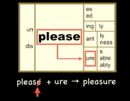A Video of Morphological Problem-Solving with a 7-Year-Old:
Deconstructing and Constructing the Spelling/Meaning of Words with with
the Matrix & Word Sum
Watch as a 7-year-old student in California is guided through the spelling/meaning connections of sets of morphologically related words words with word sums and a matrix.
Thanks to Kevin and his Grade 2 teacher, Irene Brown, for sharing this clip with WordWorks!
Developing Critical Thinking: Hypothesis generation and testing
This session begins with Kevin asking about the the word <pleasure> to confirm his understanding of how vowel suffixes operate with single, silent <e>s. Kevin is guided through a test of his hypothesis with the help of a matrix for the base <please> and word sums for some members of that morphological family that the matrix represents. Kevin’s learning is then consolidated by revisiting those same suffixing patterns by using word sums to build words of a different morphological family, this one with the base <Image>.
The video allows us to watch as Kevin’s thinking is guided by a matrix and word sums. In this short video, watch for at least three ways these tools are employed for the development of generative word knowledge and critical thinking skills central to structured word inquiry:
-
•Hypothesis generation
-
•Hypothesis testing
-
•Consolidation of newly learned word knowledge
At a couple of points, you can hear Kevin make the link between <image> and <imagination> while working on the spelling and pronunciation of different derivations of <image>. Working with word sums provides the structural framework that feeds Kevin’s insight (hypothesis generation). Then, word sums are used to confirm the accuracy of his insight (hypothesis testing). Throughout the process, the orthographic representations of morphemes and how they operate in complex words is consolidated by using word sums to help him announce the morphological structures of the words he encounters with pauses at morphemic boundaries, and stating any suffixing changes that occur.

I have long been fascinated by the assertion that orthography is human thought made visible as text. I first encountered this understanding of the written word through working with Real Spelling. I shared this idea with the model shown at left during my recent workshops at the International School of Kuala Lumpur. I also told the teachers that it took me years before I felt like I started to get my head around what this statement really means.
As I worked at editing the screen recording of this Skype session, I came to think that this clip may well be the best way I have yet found to communicate that idea. The dynamic nature of word sums growing in accordance with Kevin’s thinking really do feel like human thought being made visible as text.
Word Sums & Matrices: Teaching tools for developing vocabulary (breadth AND depth) & reading comprehension
Research on Morphology instruction & Vocabulary Learning
See the section below titled “Effects of morphological instruction on vocabulary acquisition” for a brief account of recently published research showing that morphological instruction with matrices and word sums can (a) increase students’ ability to identify bases within complex words that were not addressed by instruction, and (b) increase students’ vocabulary knowledge for words they have not been taught, but which contain bases that they have been taught.
Encountering a novel word in a sentence poses an obstacle to comprehension. However, If we recognize a familiar base within that novel word the meaning associations carried by that base morpheme can reduce the novelty of the word, and thus reduce the obstacle to our comprehension. Similarly, attending to the base in a familiar word may offer shades of meaning that could enrich our comprehension of a word and the sentence in which it is found.
However, when our learning about the written word occurs in a context of instruction which fails to draw attention to those substructures, access to meaning cues within words can elude our conscious awareness, even for words we have used for years.
The two word sums listed below regularly illustrate this point by bringing “ah-ha” moments for teachers in my workshops:
dis + ease → disease quest + ion → question
For myself, and most teachers I have worked with, the depth of understanding of these common words was limited by the fact that years of exposure to only representations of the surface structure of these words. The instruction upon which I built my understanding of the written word had never encouraged me to attend to the base words. However, the first time that I saw these simple “diagrams” of how the substructure of these words relate to their surface structure I gained access to shades of meaning that had always been there, but never reached my conscious awareness.
Meta-Analysis of Morphological Intervention Studies
Another paper (Bowers, Kirby & Deacon, 2010) was published in the June issue of Reviews of Educational Research. It reports on our findings of the existing morphological interventions in languages with the Roman Alphabet. We found:
•Literacy benefits over all;
•Less able students gained the most;
•Interventions in pre-school to Grade 2 generally brought benefits that were generally equal to, or grater than interventions in Grade 3 and above;
•Effects were generally stronger when morphological instruction was integrated with other forms of instruction.
Find a copy of that paper here.
I assume that some people make these connections without the benefit of word sums. Nevertheless, I encourage teachers to consider the significance of the fact that these simple word sums can bring new insights to mature readers for such common words. Word sums and matrices offer a way of knowing that we were denied during our own word learning experiences.
What would happen for children who were taught this way of knowing from the very beginning of their instruction?
When word sums and matrices become basic tools of literacy instruction from the beginning of schooling, children build their entire word learning experiences with explicit awareness of how those substructures relate to the meaning, spelling and pronunciation of words.
See an example of a grade 1 lesson introducing matrices and word sums here.
For a research response to the question, “How soon should morphological instruction start?” see the box to the right.
Kevin’s example of an accomplished 7-year-old morphologist
The fact that Kevin is so successful at making connections and building complex words like <image> and <imagination> at 7 years of age is evidence that young children can learn from this content. I understand why many will be shocked at the level of Kevin’s understanding displayed in this video. Remember, however, that most 7-year-olds don’t learn about words in a class like that of Irene Brown in which word sums and matrices are just one of the everyday literacy instruction tools.
Here are some examples of work that older students do when they have been working with matrices and word sums for a few months.
A Grade 4/5 class deepens its scientific understanding by investigating the structure and meaning of <condensation>.
A Grade 5/6 class investigates bound and twin bases.

Effects of morphological instruction on vocabulary acquisition

The intervention had students build word sums from the matrix shown at left to teach the spelling/meaning connection of words represented by this matrix. Notice the word <significant> is morphologically related to the base <sign> and could have been placed on this matrix but it was purposefully not addressed by the instruction. Results from our study showed that students were better at defining words that they were exposed to (e.g. any word than can be built on this matrix). They were also better at defining words they were not taught, but which are morphologically related to bases they were taught (e.g. <significant>). We also found that the experimental group were better at identifying the base of complex words, even for word families that they were never taught. This instruction increased the likelihood Grade 4 and 5 children would recognize a base in a novel word. This paper is now out in Reading & Writing: An Interdisciplinary Journal. (2010) vol. 23, pages 515–537. You can download a poster presentation of this study here. Our Teacher resource book “Teaching How the Written Word Works” includes the series of lessons used in our Grade 4/5 intervention.






